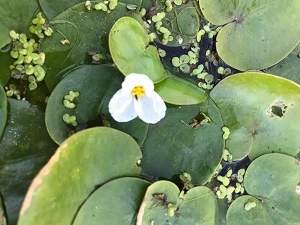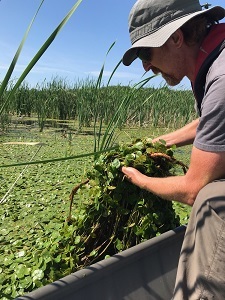|
Sept. 1, 2020
Contact: Joanne Foreman, 517-284-5814
Boaters, waterfowl hunters and anglers can help prevent further spread
The Department of Environment, Great Lakes, and Energy recently confirmed the presence of European frog-bit, an aquatic invasive plant, in four lakes within the Waterloo Recreation Area in Jackson and Washtenaw counties and one impoundment in the Dansville State Game Area in Ingham County.
Aquatic invasive species have the potential to harm Michigan’s environment, economy and human health. European frog-bit, which resembles a miniature water lily with leaves about the size of a quarter, can form dense mats on the surface of slow-moving waters like bayous, backwaters and wetlands. These mats can impede boat traffic and alter food and habitat for ducks and fish.
Spreading across Michigan
European frog-bit was first detected in southeast Michigan in 1996 and has since spread along the coastal areas of lakes Erie and Huron up to the eastern Upper Peninsula.

In 2016, the plant was discovered in Reeds and Fisk lakes in East Grand Rapids. It was found in several small bodies of water in Oakland County in 2018 and in the Lower Grand River in Ottawa County and Pentwater Lake in Oceana County in 2019.
While waterfowl, currents and stream flow can spread the plant and its seeds, European frog-bit, like most invasive species, travels farther and faster by human movement. Plant parts and seeds can become attached to boat motors, trailers, decoys and other recreational gear in an infested body of water and be transferred unintentionally to another location.
|
What is being done
To date, EGLE staff has completed surveys of bodies of water in the Dansville State Game Area and Waterloo and Pinkney state recreations areas, as well as most lakes with public access in the area, finding no additional infestations.

All visible frog-bit plants were successfully removed by hand from Mills Lake, but due to heavy infestations, Mud, Green and Winnewanna lakes and the Dansville State Game Area impoundment require more intensive response options that cannot be completed in 2020.
Survey and removal efforts are ongoing in West Michigan, where crews from the West Michigan Cooperative Invasive Species Management Area (CISMA) and the Gun Lake Tribe are working with EGLE to remove or treat infestations around heavily used boating access sites and to protect culturally and ecologically significant sites like wild rice beds in the Lower Grand River.
The Oakland County CISMA is continuing its survey of lakes and wetlands and has begun controlling the invasive plant in some infested areas.
|
What you can do
To prevent further spread of European frog-bit, boaters, waterfowl hunters and anglers should “Clean, Drain and Dry” boats, trailers and gear before moving them to a new location.
State law now requires boaters to do the following before transporting any watercraft over land:
- Remove all drain plugs from bilges, ballast tanks and live wells.
- Drain all water from live wells and bilges.
- Ensure the watercraft, trailer and all conveyances are free of aquatic organisms, including plants.
If you spend time on or around the water, learn how to identify European frog-bit and report any sightings using the Midwest Invasive Species Information Network website at MISIN.MSU.edu or the MISIN downloadable app. When reporting, be sure to note the date, time and location of the sighting and take photos if possible.
Reports also can be made to EGLE’s Aquatic Invasive Species Program by email to EGLE-WRD-ANC@michigan.gov or by calling 517-284-5593.
To find out more about European frog-bit and other aquatic invasive species, visit Michigan.gov/Invasives.
Michigan's Invasive Species Program is cooperatively implemented by the Department of Environment, Great Lakes, and Energy, the Department of Natural Resources and the Department of Agriculture & Rural Development.
/Note to editors: Accompanying photos are available below for download. Caption information follows.
Frog-bit: European frog-bit resembles small water lilies, with white, three-petaled flowers visible between June and August.
Alwin: EGLE Aquatic Biologist Tom Alwin removes European frog-bit from a backwater area in Pentwater River State Game Area.
Dansville: Dense mats of European frog-bit were found in an impoundment at the Dansville State Game Area.
Illustration: European frog-bit is a free-floating aquatic plant with small (0.5 to 2.5-inch) leaves. Illustration courtesy of Bruce Kerr./
|